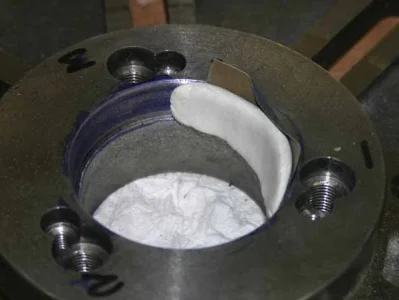Proxule
Ultra Member
Hey fellas,
I recently acquired my new 12x36 king Canada lathe, I furnished up some leveling feet using some hockey pucks, carriage bolts and some flat disks to sit atop the hockey pucks to make a vibration dampening feet. * thanks Everett for the stock !
I am in a pickle regarding my 3 jaw and 4 jaw.
My 3 jaw has a subtle vibration from 600 to 800 rpm. With and with out the jaws installed.
The jaws are all 302 grams exactly, So its likely in the body some where.
The real scary part is my 4 jaw, with the jaws out, At 600 rpms it will literally dance my lathe across the floor.
I have no static balancing rig, and looking at the rear of this 4 jaw chuck I can see excessive amount of casting material or sand? in the 4 pockets, so there will definitely be some weights added and removed.
Any one has any ideas of other ways to balance this chuck - I was thinking chucking up some stock and getting as close to zero TIR as possible, and mount the whole unit between centers to make a static balance rig, Sort of?
Any one in Edmonton have a balance I can test my chuck out on?
\Thanks guys!
Edit - Does any one know how to change the thread heading? I misspelled unbalanced - thanks
I recently acquired my new 12x36 king Canada lathe, I furnished up some leveling feet using some hockey pucks, carriage bolts and some flat disks to sit atop the hockey pucks to make a vibration dampening feet. * thanks Everett for the stock !
I am in a pickle regarding my 3 jaw and 4 jaw.
My 3 jaw has a subtle vibration from 600 to 800 rpm. With and with out the jaws installed.
The jaws are all 302 grams exactly, So its likely in the body some where.
The real scary part is my 4 jaw, with the jaws out, At 600 rpms it will literally dance my lathe across the floor.
I have no static balancing rig, and looking at the rear of this 4 jaw chuck I can see excessive amount of casting material or sand? in the 4 pockets, so there will definitely be some weights added and removed.
Any one has any ideas of other ways to balance this chuck - I was thinking chucking up some stock and getting as close to zero TIR as possible, and mount the whole unit between centers to make a static balance rig, Sort of?
Any one in Edmonton have a balance I can test my chuck out on?
\Thanks guys!
Edit - Does any one know how to change the thread heading? I misspelled unbalanced - thanks
Last edited:


